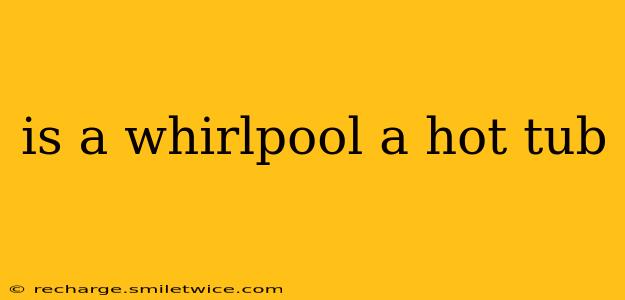The terms "whirlpool" and "hot tub" are often used interchangeably, leading to confusion. While both offer a relaxing soak in warm water, there are key distinctions. This article will clarify the differences and help you understand which is right for you.
What is a Whirlpool?
A whirlpool, often referred to as a whirlpool bath or bath tub, is typically a built-in or freestanding bathtub featuring jets that circulate water to create a massaging effect. Whirlpools are usually found in bathrooms and are designed for one to two people. They are often integrated into a bathroom's design, featuring sleek, modern aesthetics and integration with bathroom fixtures. The focus is on a therapeutic, relaxing bath experience, generally with lower water temperatures than hot tubs.
What is a Hot Tub?
A hot tub, also known as a spa or jacuzzi (though Jacuzzi is a brand name), is a larger, freestanding structure designed for multiple people. Hot tubs typically have more powerful jets, providing a more vigorous massage. They are generally outdoors, although indoor installations are possible. Hot tubs usually maintain significantly higher water temperatures than whirlpools, often reaching 100-104°F (38-40°C). The emphasis is on social interaction and relaxation, creating a more immersive and social experience.
Are there any overlaps between whirlpools and hot tubs?
Yes, there's a significant area of overlap. The lines between the two can blur. Some larger whirlpools might have multiple seats and more powerful jets, approaching the functionality of a smaller hot tub. Conversely, some smaller hot tubs might be more compact and less powerful than some larger whirlpools. The key differentiators remain size, number of users, water temperature, and intended use.
What are the main differences between a whirlpool and a hot tub?
This question highlights the core differences:
- Size and Capacity: Hot tubs are larger and accommodate multiple people, while whirlpools are typically designed for one or two individuals.
- Jet Power: Hot tubs generally have more powerful jets for a stronger massage, whereas whirlpools offer a gentler, more relaxing massage.
- Water Temperature: Hot tubs maintain higher water temperatures than whirlpools.
- Installation: Whirlpools are often built-in or freestanding within a bathroom, while hot tubs are usually freestanding and often located outdoors.
- Cost: Typically, hot tubs are more expensive than whirlpools due to their size and features.
Which one is better for me?
The "better" option depends entirely on your needs and preferences. Consider these factors:
- Space: Do you have the space for a larger hot tub, or is a smaller whirlpool more suitable for your bathroom?
- Budget: Whirlpools are generally more affordable than hot tubs.
- Desired Experience: Do you prefer a relaxing bath-like experience (whirlpool) or a more vigorous massage and social gathering (hot tub)?
- Maintenance: Hot tubs require more significant maintenance than whirlpools.
What about the energy consumption of whirlpools and hot tubs?
Both whirlpools and hot tubs consume energy, especially to heat the water. Larger hot tubs naturally consume more energy than smaller whirlpools. Energy-efficient models are available for both, featuring improved insulation and heating systems.
What are the maintenance requirements for each?
Maintaining a hot tub usually involves more frequent cleaning and chemical balancing due to the larger water volume and higher temperature, which promotes bacterial growth. Whirlpools require less maintenance but still need regular cleaning and filter changes.
In conclusion, while the terms are sometimes used interchangeably, a whirlpool is fundamentally a smaller, bathroom-focused unit, while a hot tub is a larger, often outdoor, social gathering place with stronger jets and higher water temperature. Understanding these key differences will help you choose the perfect soaking solution for your needs.
